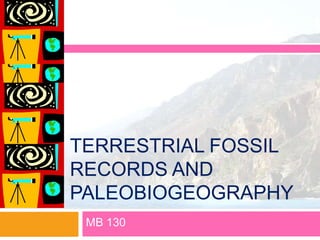
terrestrial fossil records and paleogeography
- 3. Are the preserved remnants or impressions left by organisms that lived in the past best places to find them are in lake, swamp and river deposits. In essence, they are the historical documents of biology
- 4. The fossil record is the ordered array in which fossils appear within sedimentary rocks These rocks record the passing of geological time
- 5. Sedimentary rocks are the richest source of fossils Sedimentary rocks are form from layers of sand and silt that settle to the bottom of seas and swamps As deposits pile up, they compress older sediment below them into rock The bodies of dead organisms settle along with the sediments, but only a tiny fraction are preserved as fossils Rates of sedimentation vary depending on a variety of processes, leading to the formation of
- 6. The oldest fossils are usually in the deepest layers of sedimentary rocks
- 7. Types of Terrestrial Fossils
- 8. • Amber-preserved fossils are organisms that become trapped in tree resin that hardens after the tree is buried.
- 9. • Trace fossils record the activity of an organism
- 10. Index fossils are another tool to determine the age of rock layers. • Index fossils can provide the relative age of a rock layer. – existed only during specific spans of time – occurred in large geographic areas • Index fossils include fusulinids and trilobites.
- 11. Fossils can form in several ways: Permineralization occurs when minerals carried by water are deposited around a hard structure.
- 12. A natural cast forms when flowing water removes all of the original tissue, leaving an impression
- 13. • Preserved remains form when an entire organism becomes encased in material such as ice.
- 14. • Specific conditions are needed for fossilization. • Only a tiny percentage of living things became fossils.
- 15. Determining the age of Fossils
- 16. • Radiometric dating uses decay of unstable Radiometric dating provides an accurate way to isotopes. estimate the age of fossils. – Isotopes are atoms of an element that differ in their number of neutrons. neutrons protrons
- 17. Radiometric dating uses decay of unstable isotopes. – Isotopes are atoms of an element that differ in their number of neutrons. – A half-life is the amount of time it takes for half of the isotope to decay.
- 18. parent isotope newly formed rock daughter isotope after one half-life after two half-lives Stepped Art Fig. 17-11, p. 268
- 19. • Relative dating estimates the time during which an organism lived. – It compares the placement of fossils in layers of rock. – Scientists infer the order in which species existed.
- 20. Fossils, evolution and Biogeography Biogeography Geologic time scale
- 21. Actual Data Tree of life Cambrian Time Appearance of complex Precambrian creatures Darwinian Model Created after their kind
- 22. -attempts to explain why species and higher taxa are distributed as they are, and why the diversity and taxonomic composition of the biota vary from one region to another
- 24. Geographic spread of organisms also tells of their past evolution.
- 25. MARSUPIAL EXAMPLE ? AREA CLADOGRAMS
- 26. Fossil evidence shows that marsupials evolved in the Jurassic but after the continents started to break-up, the marsupials must have got separated into two populations, one in the Americas and the other in Australasia. In fact fossil marsupials have even been found in Antarctica and South Africa as well, providing evidence that that these continents acted as a land bridge connecting the two populations for a time.
- 28. KEY CONCEPT The geologic time scale divides Earth’s history based on major past events.
- 29. • The history of Earth is represented in the geologic 100 time scale. 250 • Cumulative findings from 550 biogeography, comparative 1000 morphology, and geology led to new ways of thinking about the natural world 2000 PRECAMBRIAN TIME This time span makes up the vast majority of Earth’s history. It includes the oldest known rocks and fossils, the origin of eukaryotes, and the oldest animal fossils. Cyanobacteria
- 30. • Eras last tens to hundreds of millions of years. – consist of two or more periods – three eras: Cenozoic, Mesozoic, Paleozoic
- 31. • Periods last tens of millions of years. – most commonly used units of time on time scale – associated with rock systems. • Epochs last several million years.
- 32. Cambrian 540 – 500 Precambrian 650 - 540